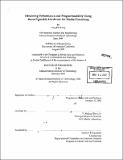Obtaining performance and programmability using reconfigurable hardware for media processing
Author(s)
Kung, Ling-Pei, 1961-
DownloadFull printable version (19.42Mb)
Other Contributors
Massachusetts Institute of Technology. Dept. of Architecture. Program In Media Arts and Sciences.
Advisor
V. Michael Bove, Jr.
Terms of use
Metadata
Show full item recordAbstract
An imperative requirement in the design of a reconfigurable computing system or in the development of a new application on such a system is performance gains. However, such developments suffer from long-and-difficult programming process, hard-to-predict performance gains, and limited scope of applications. To address these problems, we need to understand reconfigurable hardware's capabilities and limitations, its performance advantages and disadvantages, re-think reconfigurable system architectures, and develop new tools to explore its utility. We begin by examining performance contributors at the system level. We identify those from general-purpose and those from dedicated components. We propose an architecture by integrating reconfigurable hardware within the general-purpose framework. This is to avoid and minimize dedicated hardware and organization for programmability. We analyze reconfigurable logic architectures and their performance limitations. This analysis leads to a theory that reconfigurable logic can never be clocked faster than a fixed-logic design based on the same fabrication technology. Though highly unpredictable, we can obtain a quick upper bound estimate on the clock speed based on a few parameters. We also analyze microprocessor architectures and establish an analytical performance model. We use this model to estimate performance bounds using very little information on task properties. These bounds help us to detect potential memory-bound tasks. For a compute-bound task, we compare its performance upper bound with the upper bound on reconfigurable clock speed to further rule out unlikely speedup candidates. (cont.) These performance estimates require very few parameters, and can be quickly obtained without writing software or hardware codes. They can be integrated with design tools as front end tools to explore speedup opportunities without costly trials. We believe this will broaden the applicability of reconfigurable computing.
Description
Thesis (Ph. D.)--Massachusetts Institute of Technology, School of Architecture and Planning, Program in Media Arts and Sciences, 2002. Includes bibliographical references (p. 127-132).
Date issued
2002Department
Program in Media Arts and Sciences (Massachusetts Institute of Technology)Publisher
Massachusetts Institute of Technology
Keywords
Architecture. Program In Media Arts and Sciences.